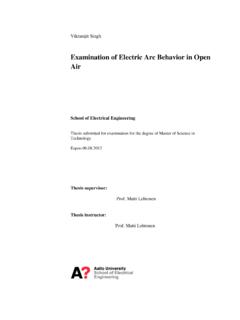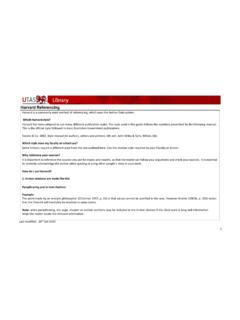Transcription of Theories of ICT System - TKK
1 ISBN: 978-952-60-4150-6 (pdf) ISSN-L: 1799-4896 ISSN: 1799-490X (pdf) Aalto University Aalto University School of Science Department of Industrial Engineering and Management BUSINESS + ECONOMY ART + DESIGN + ARCHITECTURE SCIENCE + TECHNOLOGY CROSSOVER DOCTORAL DISSERTATIONS Aalto-ST 9/2011 Department of Industrial Engineering and Management WORKING PAPERS SCIENCE + TECHNOLOGY Theories of ICT System Implementation and Adoption A Critical Review Eija Korpelainen Aalto University School of Science Department of Industrial Engineering and Management Working Paper 2011 Helsinki 2011 Theories of ICT System Implementation and Adoption A Critical Review Eija Korpelainen Aalto University School of Science and Technology Department of Industrial Engineering
2 And Management 15500 FIN-00076 AALTO FINLAND Tel.: +358 9 470 22846 Fax: +358 9 470 23665 Internet: Eija Korpelainen e-mail: (at) All rights reserved. No part of this publication may be reproduced, stored in retrieval systems, or transmitted, in any form or by any means, electronic, mechanical, photocopying, microfilming, recording, or otherwise, without permission in writing from the publisher. Aalto Print Helsinki 2011 ABSTRACT The purpose of this paper is to map and examine what Theories and models of ICT System implementation and adoption are used in management and business research. The focus is on the most influential Theories and models, and how they are applied in the research papers.
3 For this purpose, a comprehensive sample of the articles (N=1303) on this topic published between 1999 and 2010 in high-quality management and business journals was analyzed using citation analysis and qualitative content analysis. The results show that during this time the research field provided Theories and models to examine the adoption and acceptance of ICT by individuals. The articles focused on a variety of extensions of the Technology Acceptance Model (TAM). The advantage of focusing on TAM is that it is a simple and parsimonious model, which has encouraged researchers to apply it widely. The weaknesses were that previous studies have not been able to integrate contextual factors into TAM, and the research field applied a single and unnecessarily restrictive methodological approach.
4 Future research might benefit from studies which would focus on the implementation and adoption processes and their consequences by drawing on the learning and change management literatures. Additionally, research could also exploit more qualitative and interpretive approaches generating new and unexpected knowledge. Keywords adoption, citation analysis, implementation, information systems, information technology, information and communication technology, learning, management and business research, technology acceptance models. ACKNOWLEDGEMENTS This research was supported by the Doctoral Program for Multidisciplinary Research on Learning Environments, Finland, and the Finnish Work Environment Fund.
5 I would like to acknowledge the helpful comments from Prof. Matti Vartiainen, Dr. Mari Kira, Dr. Niina Rintala, and Techn. Hanna Timonen. TABLE OF CONTENTS 1 1 2 METHODS AND DATA .. 4 Data Collection .. 5 Data Analysis .. 6 Limitations of citation Analysis in this Study .. 9 3 RESULTS .. 11 Description of the Research Field .. 11 Most Cited Theories on ICT System Implementation and Adoption .. 13 Applications and Outcomes of the Influential Theories and Models .. 18 Role of Learning .. 23 4 DISCUSSION: THE STRENGTHS AND LIMITATIONS OF THE PREVIOUS RESEARCH ..25 Strengths of Previous Research .. 25 Limitations of Previous Research .. 26 5 CONCLUSIONS: SUGGESTIONS FOR FUTURE RESEARCH STREAMS.
6 30 REFERENCES .. 32 APPENDICES .. 41 1 1 INTRODUCTION Information and communication technology (ICT) systems are widely used in organizations. Their use has many favorable consequences, because they support interaction and collaboration, workplace learning (Andriessen, 2003), and work performance (Ciborra and Patriotta, 1996; Jones and Kochtanek, 2004; Nunamaker, 1997; Orlikowski, 1996). Several studies demonstrate that ICT investments are beneficial for performance and productivity ( , Bharadwaj et al., 1999; Hitt and Brynjolfsson, 1996). However, the implementation of an ICT System always entails both organizational and individual changes ( , Rogers, 1995, 395; Van de Ven, 1986), and therefore user adoption and establishing the use of ICT systems have proven challenging in organizations (Bullen and Bennet, 1990; Burns et al.)
7 , 1991; Grudin, 1989; Kwon and Zmud, 1987; Orlikowski,1993). The challenges and problems associated with the implementation and adoption of ICT systems have led scholars and practitioners to seek to understand and manage the processes and phenomena related to the topic, spawning an extensive literature on the field ( , Jeyaraj et al., 2006). Many reviews have been conducted addressing ICT implementation and adoption in organizations. Jeyaraj et al. (2006) reviewed 115 empirical studies focusing on the coding of dependent and independent variables affecting ICT adoption. Venkates et al. (2003) reviewed user acceptance literature and discussed eight prominent models in order to propose a unified theory of the acceptance and use of technology.
8 The Technology Acceptance Model (TAM) in particular has given rise to many reviews. Lee et al. (2003) made a meta-analysis and survey on 101 TAM studies. They focused on the progress, limitations, and future directions of TAM. Legris et al. (2003) reviewed 22 TAM articles. Their meta-analysis focused on the incremental development of TAM, and addressed the strengths and limitations of the model. Turner et al. (2010, analyzing 73 publications), King and He (2006, analyzing 88 papers) and Ma and Liu (2004, analyzing 26 studies) also performed meta-analyses of the results of TAM studies. Yousafzai et al. (2007) made a narrative literature review of 145 TAM papers to progress towards a unified view of TAM.
9 Somewhat earlier reviews focus on Diffusion of Innovations (DOI). For example, Fickman (1992) performed a critical review of 18 empirical DOI studies. 2 The review focuses on different adoption contexts and their match with the context in which the classical diffusion theory was developed. Prescott and Conger (1995) reviewed 70 DOI studies. They focused on the comparison of the research results in order to evaluate the appropriateness of using DOI theory. To sum up, previous reviews focus on analyzing the functionality and validity of implementation and adoption Theories and models. They often examine one theory or model and base their findings on a relatively small sample of articles.
10 Thus, they do not provide a comprehensive state-of-the-art overview of the most influential Theories and their applications that are used in implementation and adoption research. Thus, a wide, comprehensive and structured review of the most influential Theories and models, their research subjects, and contribution to ICT implementation and adoption studies seems to be lacking. I formulated three research questions concerning the literature on the implementation and adoption of ICT systems in management and business research. 1. What Theories and models are used by the most cited publications (articles and books) to analyze and understand ICT System implementation and adoption? 2. How are the Theories and models applied and what themes are addressed in the most cited articles in ICT System implementation and adoption research?














